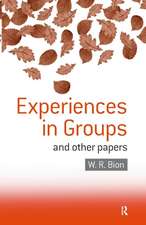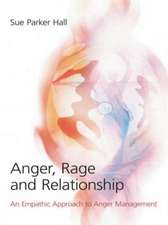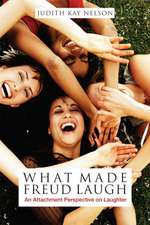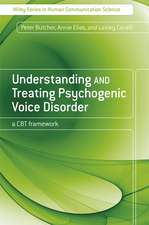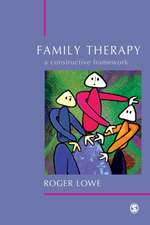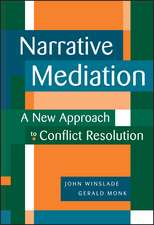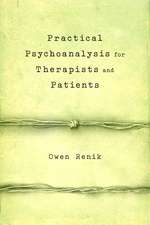Psychoanalytic Therapy with Infants and their Parents: Practice, Theory, and Results
Autor Björn Salomonssonen Limba Engleză Hardback – 26 feb 2014
Björn Salomonsson argues that attachment concepts, though important, cannot solely help explain everyday problems with breastfeeding, sleeping, and weaning, or more recalcitrant interaction disorders. He shows how we also need psychoanalytic concepts to better understand, not only such "baby worries", but also adult clients' non-verbal communications and interactions. Throughout, he uses extensive practice-based examples and also refers to his research which provides evidence for the effectiveness of this practice.
Psychoanalytic Therapy with Infants and Parents provides a unique perspective on working psychoanalytically with parents and infants. This book will be essential reading for psychoanalysts and therapists working with children as well as adults.
| Toate formatele și edițiile | Preț | Express |
|---|---|---|
| Paperback (1) | 398.82 lei 43-57 zile | |
| Taylor & Francis – 23 ian 2014 | 398.82 lei 43-57 zile | |
| Hardback (1) | 1412.13 lei 43-57 zile | |
| Taylor & Francis – 26 feb 2014 | 1412.13 lei 43-57 zile |
Preț: 1412.13 lei
Preț vechi: 1486.45 lei
-5% Nou
Puncte Express: 2118
Preț estimativ în valută:
270.20€ • 282.88$ • 223.58£
270.20€ • 282.88$ • 223.58£
Carte tipărită la comandă
Livrare economică 07-21 aprilie
Preluare comenzi: 021 569.72.76
Specificații
ISBN-13: 9780415718561
ISBN-10: 0415718562
Pagini: 232
Ilustrații: 10 b/w images and 2 tables
Dimensiuni: 156 x 234 x 15 mm
Greutate: 0.48 kg
Ediția:New.
Editura: Taylor & Francis
Colecția Routledge
Locul publicării:Oxford, United Kingdom
ISBN-10: 0415718562
Pagini: 232
Ilustrații: 10 b/w images and 2 tables
Dimensiuni: 156 x 234 x 15 mm
Greutate: 0.48 kg
Ediția:New.
Editura: Taylor & Francis
Colecția Routledge
Locul publicării:Oxford, United Kingdom
Public țintă
Postgraduate, Professional, and Professional Practice & DevelopmentCuprins
Introduction. Primal Representations – Three-Month-Old Tina. Containment –Maternal Music and Paternal Worlds With Three-Month-Old Frida. What Does a Baby Understand? – Eight-Month-Old Karen. An Infant’s Experience of Mother’s Depression – Sixteen-Month-Old Beate. The Infant "Within " the Adult – Interacting With Monica. The Living Fossil – Tristan’s Urvergessen. Classical Concepts Revisited I – Primal Repression. Classical Concepts Revisited II – Infantile Sexuality. Classical Concepts Revisited III – Transference. Mother-Infant Psychoanalytic Treatment – Does it Work? Epilogue.
Recenzii
"Talking to babies is usually associated with "babyish" talk, or at the most, with "motherese"… This book is about "talking true" to the baby and to his/her parents altogether; naming their affects and wondering about their representations one of the other. …The clinical vignettes used throughout the book illustrate, in a lively and simple manner, the ways the baby plays a role by its very presence in the therapy room… The author is one of the few clinicians who have dared to quantify the impact of psychoanalytical treatment." - Miri Keren, M.D., WAIMH President.
"This extraordinary, ground-breaking work introduces us to a newly emerging psychoanalytic field, that of the application of psychoanalytic theory and technique; not just to the traditional infant/mother dyad, but to the infant in his/her own right separately as well as together with mother. … Central to the author’s point of view is his innovative belief that even the youngest infants can communicate and understand communication by virtue of their ability to employ an inchoate, pre-lexical, affect-based language including, signs, prosody, gestures, and priming." - James S. Grotstein
"This book is not only fascinating. It also has the courage to open up a new and original thread of research in psychoanalysis, namely the exploration of the "basic grammar" of the baby worries. No child is too young to be listened to, understood and if necessary addressed. …This is not only a ground-breaking text in the field of theory. It is also a comprehensive handbook, full of precious data on the practice of infant-parent psychotherapy. It will provide a revolution for all professionals working with babies." - Antonino Ferro, is President of the Italian Psychoanalytic Society and also Consultant Associate Editor of the International Journal of Psychoanalysis.
"Salomonsson's writing is clear, elegant and engaging. The fact that he draws from fields as varied as clinical work with infants, several veins of psychoanalytic theory, the philosophy of language, developmental psychology, neuropsychoanalyis, and Wagner's opera Tristan und Isolde means that his readers are in for a bit of vigorous mental exercise. I believe that they will find the effort worthwhile and that, by the end, they will find that their own conceptions of the talking cure have expanded." - Paul M. Brinich, PsycCRITIQUES
"Talking to babies is usually associated with "babyish" talk, or at the most, with "motherese"… This book is about "talking true" to the baby and to his/her parents altogether; naming their affects and wondering about their representations one of the other. …The clinical vignettes used throughout the book illustrate, in a lively and simple manner, the ways the baby plays a role by its very presence in the therapy room… The author is one of the few clinicians who have dared to quantify the impact of psychoanalytical treatment." - Miri Keren, M.D., WAIMH President.
"This extraordinary, ground-breaking work introduces us to a newly emerging psychoanalytic field, that of the application of psychoanalytic theory and technique; not just to the traditional infant/mother dyad, but to the infant in his/her own right separately as well as together with mother. … Central to the author’s point of view is his innovative belief that even the youngest infants can communicate and understand communication by virtue of their ability to employ an inchoate, pre-lexical, affect-based language including, signs, prosody, gestures, and priming." - James S. Grotstein
"This book is not only fascinating. It also has the courage to open up a new and original thread of research in psychoanalysis, namely the exploration of the "basic grammar" of the baby worries. No child is too young to be listened to, understood and if necessary addressed. …This is not only a ground-breaking text in the field of theory. It is also a comprehensive handbook, full of precious data on the practice of infant-parent psychotherapy. It will provide a revolution for all professionals working with babies." - Antonino Ferro, is President of the Italian Psychoanalytic Society and also Consultant Associate Editor of the International Journal of Psychoanalysis.
"Salomonsson's writing is clear, elegant and engaging. The fact that he draws from fields as varied as clinical work with infants, several veins of psychoanalytic theory, the philosophy of language, developmental psychology, neuropsychoanalyis, and Wagner's opera Tristan und Isolde means that his readers are in for a bit of vigorous mental exercise. I believe that they will find the effort worthwhile and that, by the end, they will find that their own conceptions of the talking cure have expanded." - Paul M. Brinich, PsycCRITIQUES
"This book asks important questions. What goes on in a baby’s mind? How do we account for this? Can a baby have a relationship with the therapist? If so, how? How do we understand and define this relationship? Significantly, the author distinguishes between infantile transference and what he calls ‘infant transference’, and argues that it is possible that the infant unconsciously and therefore directly transfers onto the therapist feelings that might originally belong in his relationship with his parents. And, how do we understand the unconscious from a developmental perspective? Is there such a thing? Could psychoanalysis be part of a convincing evidence base for work with infants and parents?" - Chau-Yee Lo, Child and Adolescent Psychotherapist for Psychoanalytic Psychotherapy
"This extraordinary, ground-breaking work introduces us to a newly emerging psychoanalytic field, that of the application of psychoanalytic theory and technique; not just to the traditional infant/mother dyad, but to the infant in his/her own right separately as well as together with mother. … Central to the author’s point of view is his innovative belief that even the youngest infants can communicate and understand communication by virtue of their ability to employ an inchoate, pre-lexical, affect-based language including, signs, prosody, gestures, and priming." - James S. Grotstein
"This book is not only fascinating. It also has the courage to open up a new and original thread of research in psychoanalysis, namely the exploration of the "basic grammar" of the baby worries. No child is too young to be listened to, understood and if necessary addressed. …This is not only a ground-breaking text in the field of theory. It is also a comprehensive handbook, full of precious data on the practice of infant-parent psychotherapy. It will provide a revolution for all professionals working with babies." - Antonino Ferro, is President of the Italian Psychoanalytic Society and also Consultant Associate Editor of the International Journal of Psychoanalysis.
"Salomonsson's writing is clear, elegant and engaging. The fact that he draws from fields as varied as clinical work with infants, several veins of psychoanalytic theory, the philosophy of language, developmental psychology, neuropsychoanalyis, and Wagner's opera Tristan und Isolde means that his readers are in for a bit of vigorous mental exercise. I believe that they will find the effort worthwhile and that, by the end, they will find that their own conceptions of the talking cure have expanded." - Paul M. Brinich, PsycCRITIQUES
"Talking to babies is usually associated with "babyish" talk, or at the most, with "motherese"… This book is about "talking true" to the baby and to his/her parents altogether; naming their affects and wondering about their representations one of the other. …The clinical vignettes used throughout the book illustrate, in a lively and simple manner, the ways the baby plays a role by its very presence in the therapy room… The author is one of the few clinicians who have dared to quantify the impact of psychoanalytical treatment." - Miri Keren, M.D., WAIMH President.
"This extraordinary, ground-breaking work introduces us to a newly emerging psychoanalytic field, that of the application of psychoanalytic theory and technique; not just to the traditional infant/mother dyad, but to the infant in his/her own right separately as well as together with mother. … Central to the author’s point of view is his innovative belief that even the youngest infants can communicate and understand communication by virtue of their ability to employ an inchoate, pre-lexical, affect-based language including, signs, prosody, gestures, and priming." - James S. Grotstein
"This book is not only fascinating. It also has the courage to open up a new and original thread of research in psychoanalysis, namely the exploration of the "basic grammar" of the baby worries. No child is too young to be listened to, understood and if necessary addressed. …This is not only a ground-breaking text in the field of theory. It is also a comprehensive handbook, full of precious data on the practice of infant-parent psychotherapy. It will provide a revolution for all professionals working with babies." - Antonino Ferro, is President of the Italian Psychoanalytic Society and also Consultant Associate Editor of the International Journal of Psychoanalysis.
"Salomonsson's writing is clear, elegant and engaging. The fact that he draws from fields as varied as clinical work with infants, several veins of psychoanalytic theory, the philosophy of language, developmental psychology, neuropsychoanalyis, and Wagner's opera Tristan und Isolde means that his readers are in for a bit of vigorous mental exercise. I believe that they will find the effort worthwhile and that, by the end, they will find that their own conceptions of the talking cure have expanded." - Paul M. Brinich, PsycCRITIQUES
"This book asks important questions. What goes on in a baby’s mind? How do we account for this? Can a baby have a relationship with the therapist? If so, how? How do we understand and define this relationship? Significantly, the author distinguishes between infantile transference and what he calls ‘infant transference’, and argues that it is possible that the infant unconsciously and therefore directly transfers onto the therapist feelings that might originally belong in his relationship with his parents. And, how do we understand the unconscious from a developmental perspective? Is there such a thing? Could psychoanalysis be part of a convincing evidence base for work with infants and parents?" - Chau-Yee Lo, Child and Adolescent Psychotherapist for Psychoanalytic Psychotherapy
Descriere
This book provides a clear guide to work with distressed babies and unhappy parents, a numerous clinical group so often in need of urgent help.


